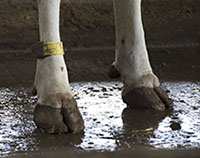 Is lameness an issue in your herd? If so, you are not alone. According to Nigel Cook, D.V.M., from the University of Wisconsin School of Veterinary Medicine, "Lameness is a global problem."
Is lameness an issue in your herd? If so, you are not alone. According to Nigel Cook, D.V.M., from the University of Wisconsin School of Veterinary Medicine, "Lameness is a global problem."During a Professional Dairy Producers of Wisconsin (PDPW) hoof care workshop, Cook indicated that about one in four cows around the world has some kind of lameness issue. "Twenty five percent is not very good. We need to find ways to do better," he said.
One aspect of a lameness control program is the use of a footbath. On many farms, a traditional 6-foot-long footbath is common. Unfortunately, 6 feet is not really long enough to do the job.
"A longer footbath works better than a shorter one," said Cook.
How long is long enough? Cook recommends a footbath be 10 to 12 feet in length. "That way, every foot gets two dunks," he said. With a ten-foot-long footbath, we can be sure every foot is immersed in the solution twice. With 12 feet, half of the cows will even get a third dunk for their back feet, Cook noted.
Some may worry that a longer footbath will use more solution, but Cook explained that if you make it narrow, it's still a 50-gallon footbath. His recommendation is to build the footbath 12 feet long and 24 inches wide. Make it 10 inches deep, which can then be filled with 3.5 inches of solution. To create a tunnel and improve cow flow, add solid sidewalls and slope the sidewalls starting from 3 feet above the floor down to the upper edge of the bath.
With this narrow design, it is advised to create a hinge drop panel on one side of the footbath so that if a cow fell and couldn't get up, it could be assisted.
The number of footbaths run per week depends on the herd. Cook suggested that farms start with a 3 days per week regime and adjust accordingly based on outcomes.
Barn design, flooring, nutrition, regularly scheduled trims and early detection of hoof issues all work alongside a properly designed footbath to minimize lameness in the herd.
"Lameness impacts everything a cow does in her day," said Cook. Getting the footbath right is a step in the right direction in improving hoof health on your dairy.

The author is an associate editor and covers animal health, dairy housing and equipment, and nutrient management. She grew up on a dairy farm near Plymouth, Wis., and previously served as a University of Wisconsin agricultural extension agent. She received a master's degree from North Carolina State University and a bachelor's from University of Wisconsin-Madison.








